DODGE AVENGER 2008 Owners Manual
Manufacturer: DODGE, Model Year: 2008, Model line: AVENGER, Model: DODGE AVENGER 2008Pages: 467, PDF Size: 7.16 MB
Page 331 of 467
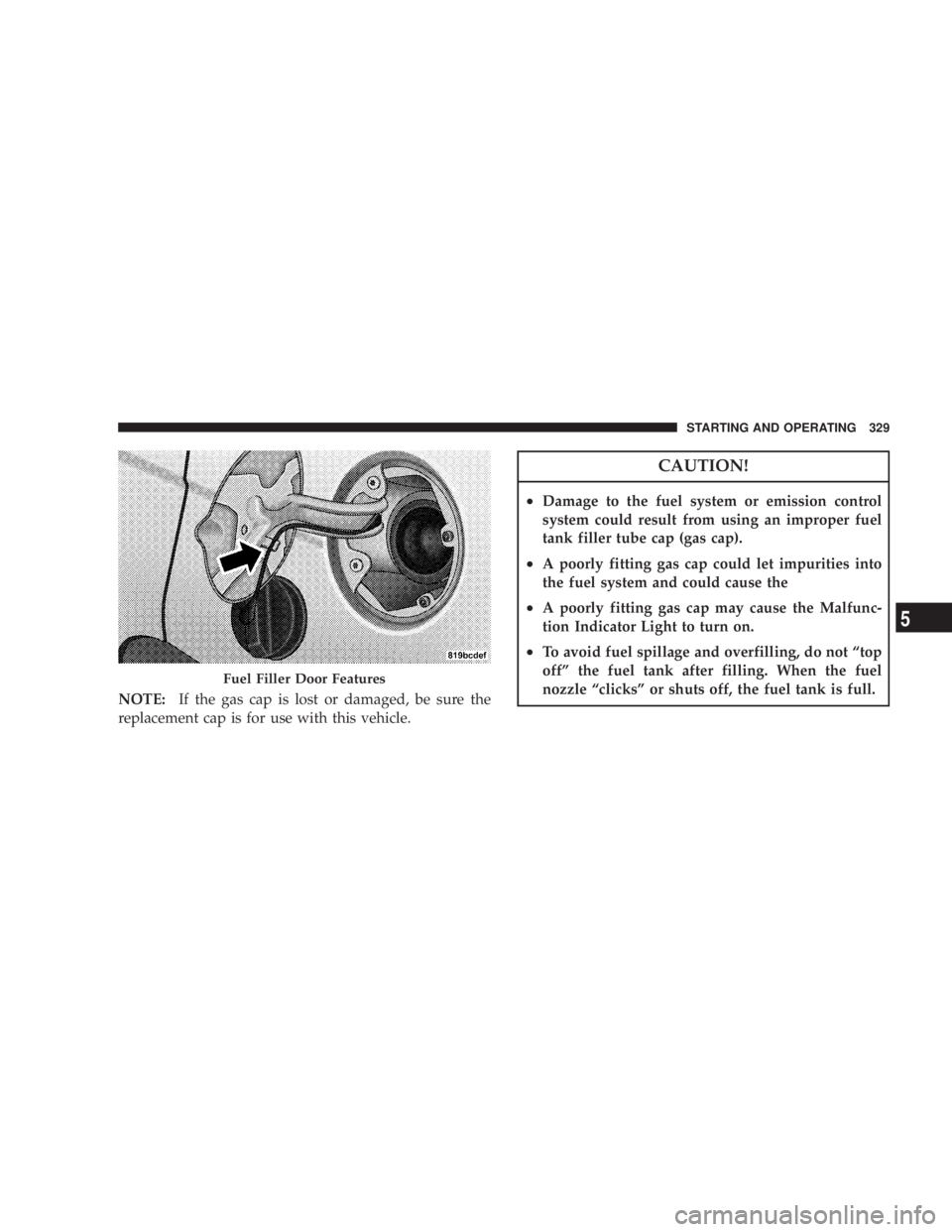
NOTE: If the gas cap is lost or damaged, be sure the
replacement cap is for use with this vehicle. CAUTION!² Damage to the fuel system or emission control
system could result from using an improper fuel
tank filler tube cap (gas cap).
² A poorly fitting gas cap could let impurities into
the fuel system and could cause the
² A poorly fitting gas cap may cause the Malfunc-
tion Indicator Light to turn on.
² To avoid fuel spillage and overfilling, do not ªtop
offº the fuel tank after filling. When the fuel
nozzle ªclicksº or shuts off, the fuel tank is full.Fuel Filler Door Features STARTING AND OPERATING 329
5
Page 332 of 467
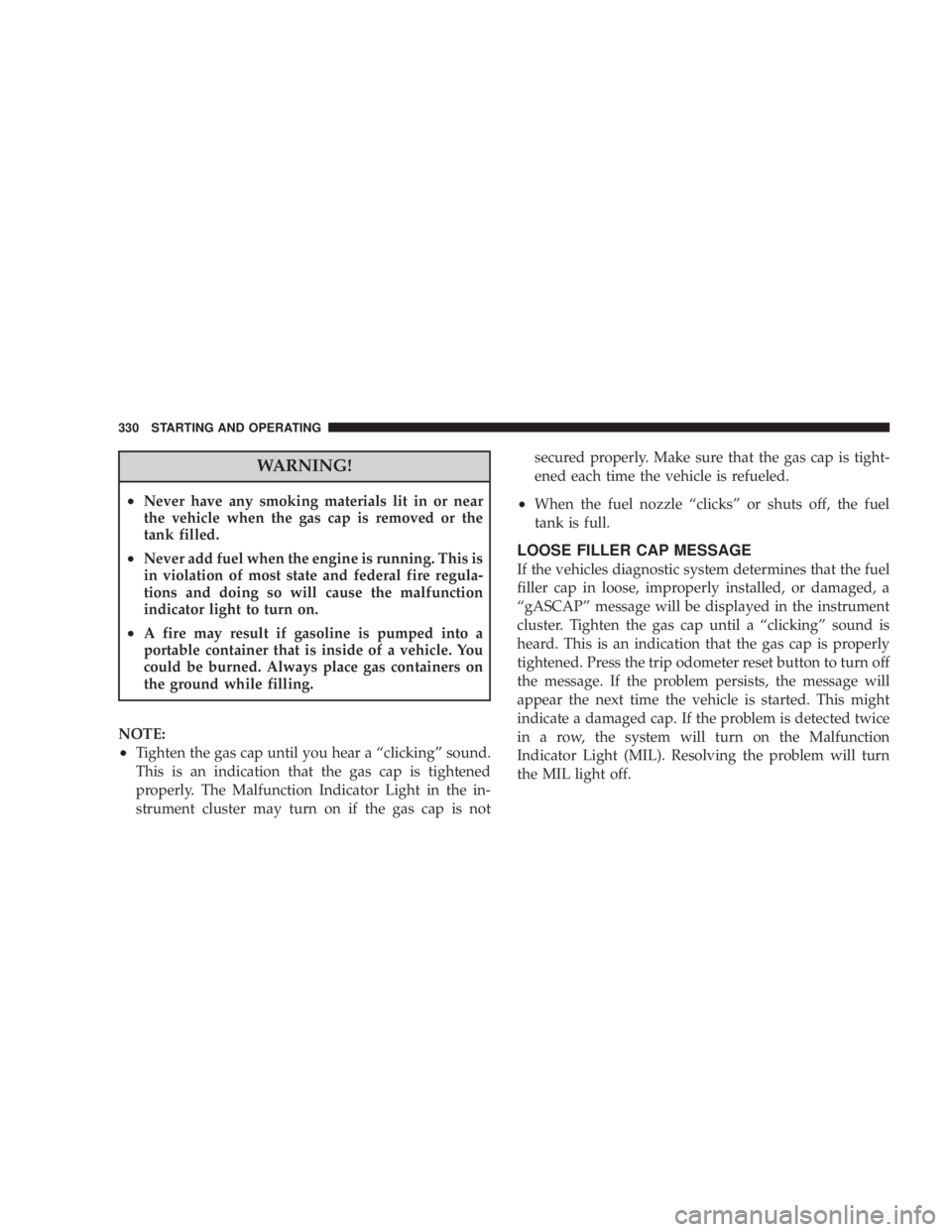
WARNING!² Never have any smoking materials lit in or near
the vehicle when the gas cap is removed or the
tank filled.
² Never add fuel when the engine is running. This is
in violation of most state and federal fire regula-
tions and doing so will cause the malfunction
indicator light to turn on.
² A fire may result if gasoline is pumped into a
portable container that is inside of a vehicle. You
could be burned. Always place gas containers on
the ground while filling.
NOTE:
² Tighten the gas cap until you hear a ªclickingº sound.
This is an indication that the gas cap is tightened
properly. The Malfunction Indicator Light in the in-
strument cluster may turn on if the gas cap is not secured properly. Make sure that the gas cap is tight-
ened each time the vehicle is refueled.
² When the fuel nozzle ªclicksº or shuts off, the fuel
tank is full.
LOOSE FILLER CAP MESSAGE
If the vehicles diagnostic system determines that the fuel
filler cap in loose, improperly installed, or damaged, a
ªgASCAPº message will be displayed in the instrument
cluster. Tighten the gas cap until a ªclickingº sound is
heard. This is an indication that the gas cap is properly
tightened. Press the trip odometer reset button to turn off
the message. If the problem persists, the message will
appear the next time the vehicle is started. This might
indicate a damaged cap. If the problem is detected twice
in a row, the system will turn on the Malfunction
Indicator Light (MIL). Resolving the problem will turn
the MIL light off.330 STARTING AND OPERATING
Page 333 of 467
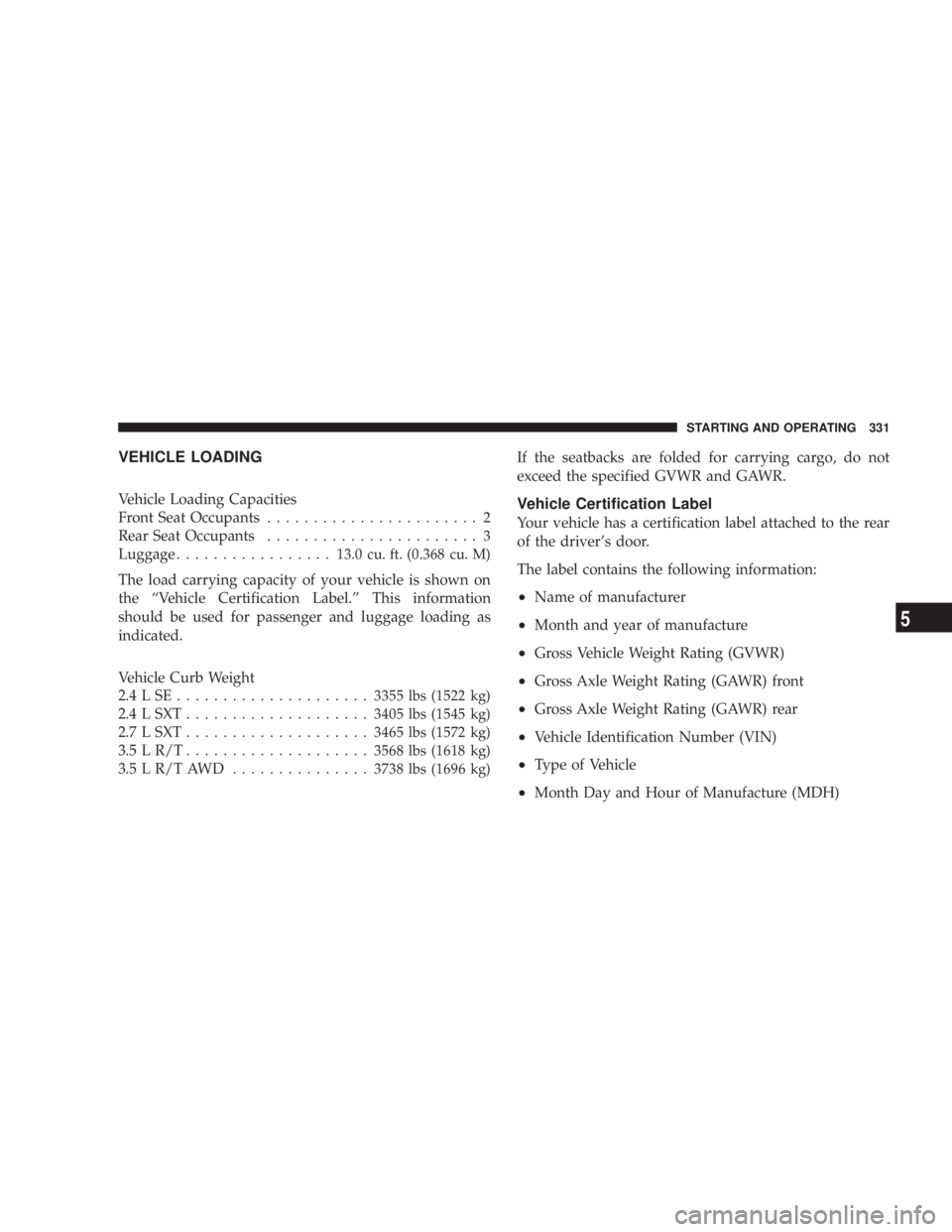
VEHICLE LOADING
Vehicle Loading Capacities
Front Seat Occupants ....................... 2
Rear Seat Occupants ....................... 3
Luggage ................. 13.0 cu. ft. (0.368 cu. M)
The load carrying capacity of your vehicle is shown on
the ªVehicle Certification Label.º This information
should be used for passenger and luggage loading as
indicated.
Vehicle Curb Weight
2.4 L SE ..................... 3355 lbs (1522 kg)
2.4 L SXT .................... 3405 lbs (1545 kg)
2.7 L SXT .................... 3465 lbs (1572 kg)
3.5 L R/T .................... 3568 lbs (1618 kg)
3.5 L R/T AWD ............... 3738 lbs (1696 kg) If the seatbacks are folded for carrying cargo, do not
exceed the specified GVWR and GAWR.
Vehicle Certification Label
Your vehicle has a certification label attached to the rear
of the driver's door.
The label contains the following information:
² Name of manufacturer
² Month and year of manufacture
² Gross Vehicle Weight Rating (GVWR)
² Gross Axle Weight Rating (GAWR) front
² Gross Axle Weight Rating (GAWR) rear
² Vehicle Identification Number (VIN)
² Type of Vehicle
² Month Day and Hour of Manufacture (MDH) STARTING AND OPERATING 331
5
Page 334 of 467
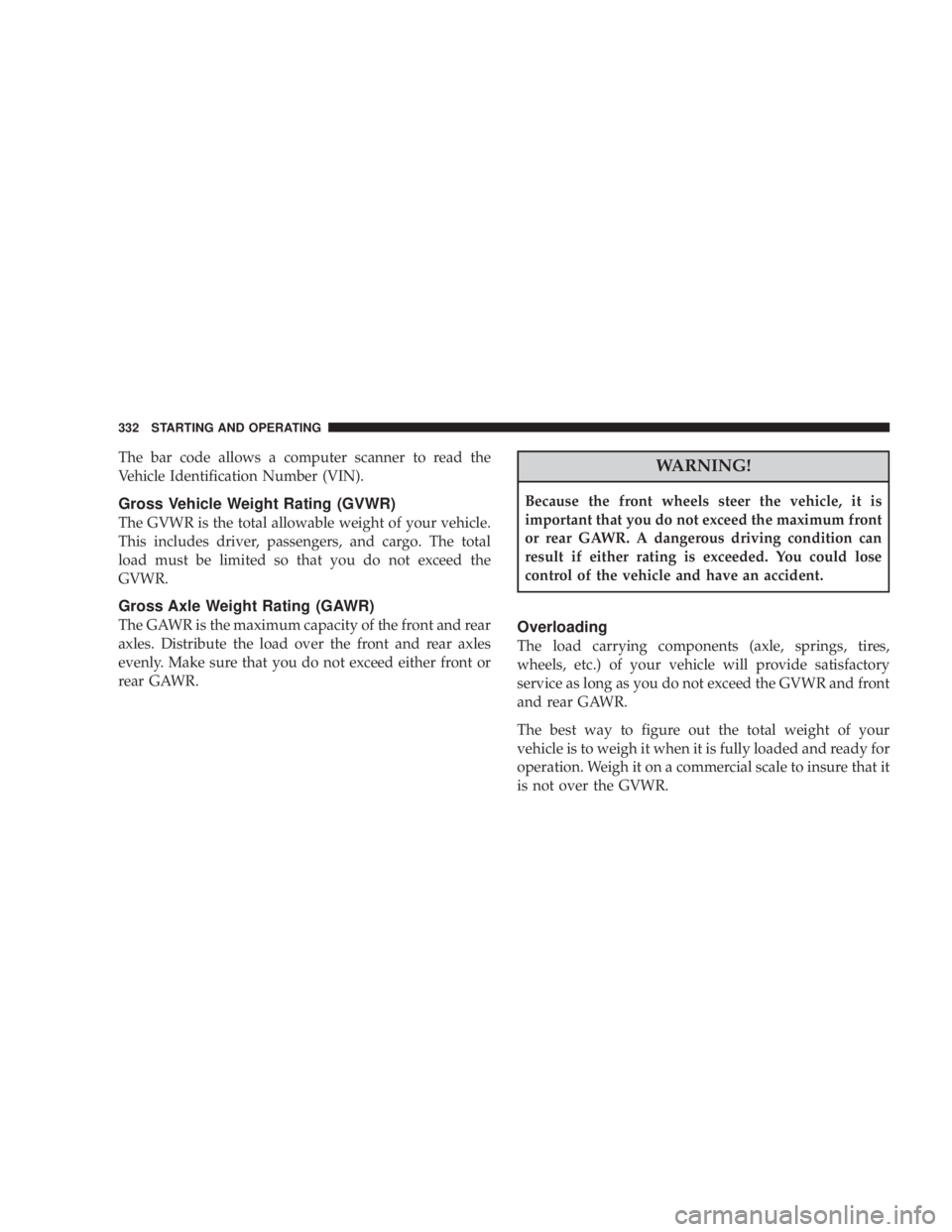
The bar code allows a computer scanner to read the
Vehicle Identification Number (VIN).
Gross Vehicle Weight Rating (GVWR)
The GVWR is the total allowable weight of your vehicle.
This includes driver, passengers, and cargo. The total
load must be limited so that you do not exceed the
GVWR.
Gross Axle Weight Rating (GAWR)
The GAWR is the maximum capacity of the front and rear
axles. Distribute the load over the front and rear axles
evenly. Make sure that you do not exceed either front or
rear GAWR. WARNING!Because the front wheels steer the vehicle, it is
important that you do not exceed the maximum front
or rear GAWR. A dangerous driving condition can
result if either rating is exceeded. You could lose
control of the vehicle and have an accident.
Overloading
The load carrying components (axle, springs, tires,
wheels, etc.) of your vehicle will provide satisfactory
service as long as you do not exceed the GVWR and front
and rear GAWR.
The best way to figure out the total weight of your
vehicle is to weigh it when it is fully loaded and ready for
operation. Weigh it on a commercial scale to insure that it
is not over the GVWR.332 STARTING AND OPERATING
Page 335 of 467
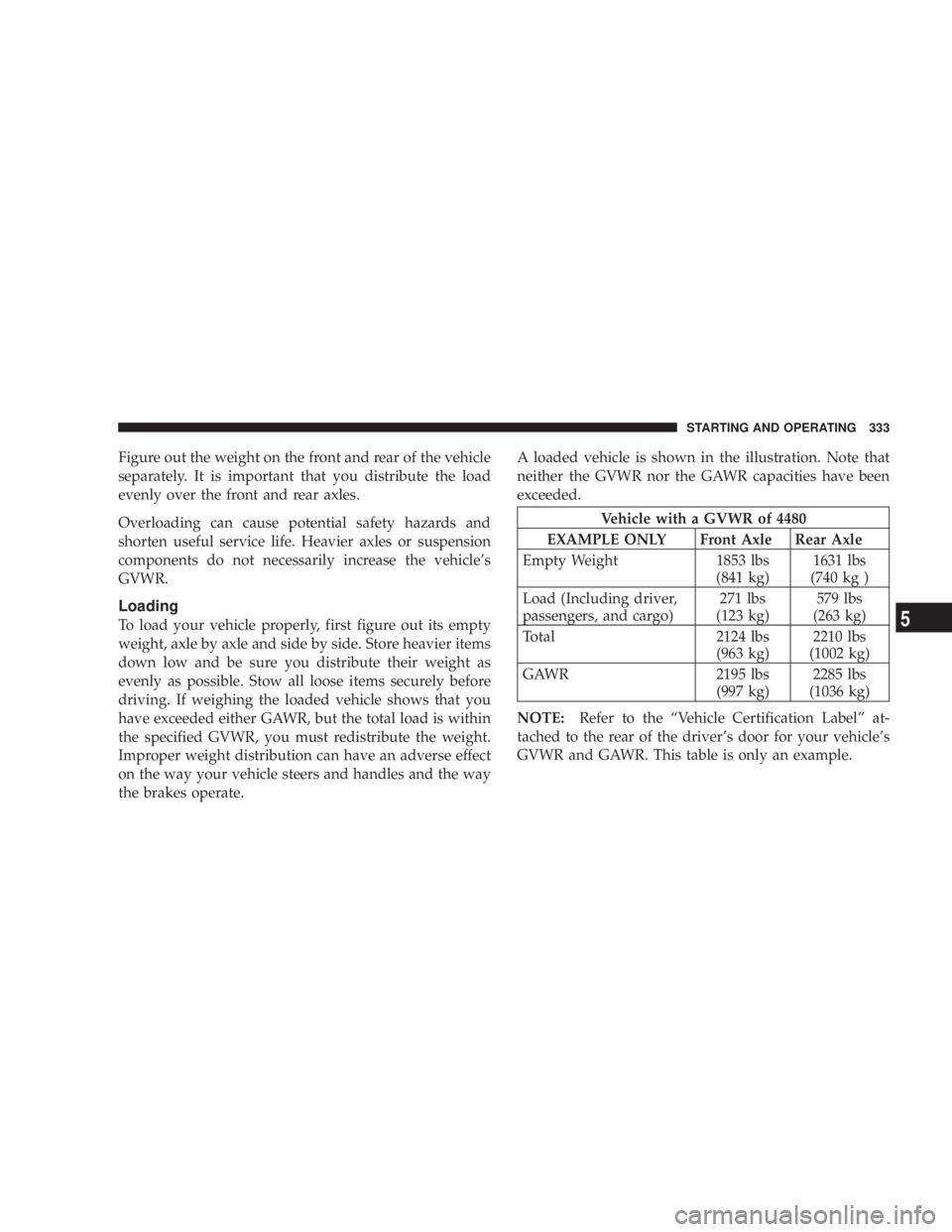
Figure out the weight on the front and rear of the vehicle
separately. It is important that you distribute the load
evenly over the front and rear axles.
Overloading can cause potential safety hazards and
shorten useful service life. Heavier axles or suspension
components do not necessarily increase the vehicle's
GVWR.
Loading
To load your vehicle properly, first figure out its empty
weight, axle by axle and side by side. Store heavier items
down low and be sure you distribute their weight as
evenly as possible. Stow all loose items securely before
driving. If weighing the loaded vehicle shows that you
have exceeded either GAWR, but the total load is within
the specified GVWR, you must redistribute the weight.
Improper weight distribution can have an adverse effect
on the way your vehicle steers and handles and the way
the brakes operate. A loaded vehicle is shown in the illustration. Note that
neither the GVWR nor the GAWR capacities have been
exceeded.
Vehicle with a GVWR of 4480
EXAMPLE ONLY Front Axle Rear Axle
Empty Weight 1853 lbs
(841 kg) 1631 lbs
(740 kg )
Load (Including driver,
passengers, and cargo) 271 lbs
(123 kg) 579 lbs
(263 kg)
Total 2124 lbs
(963 kg) 2210 lbs
(1002 kg)
GAWR 2195 lbs
(997 kg) 2285 lbs
(1036 kg)
NOTE: Refer to the ªVehicle Certification Labelº at-
tached to the rear of the driver's door for your vehicle's
GVWR and GAWR. This table is only an example. STARTING AND OPERATING 333
5
Page 336 of 467
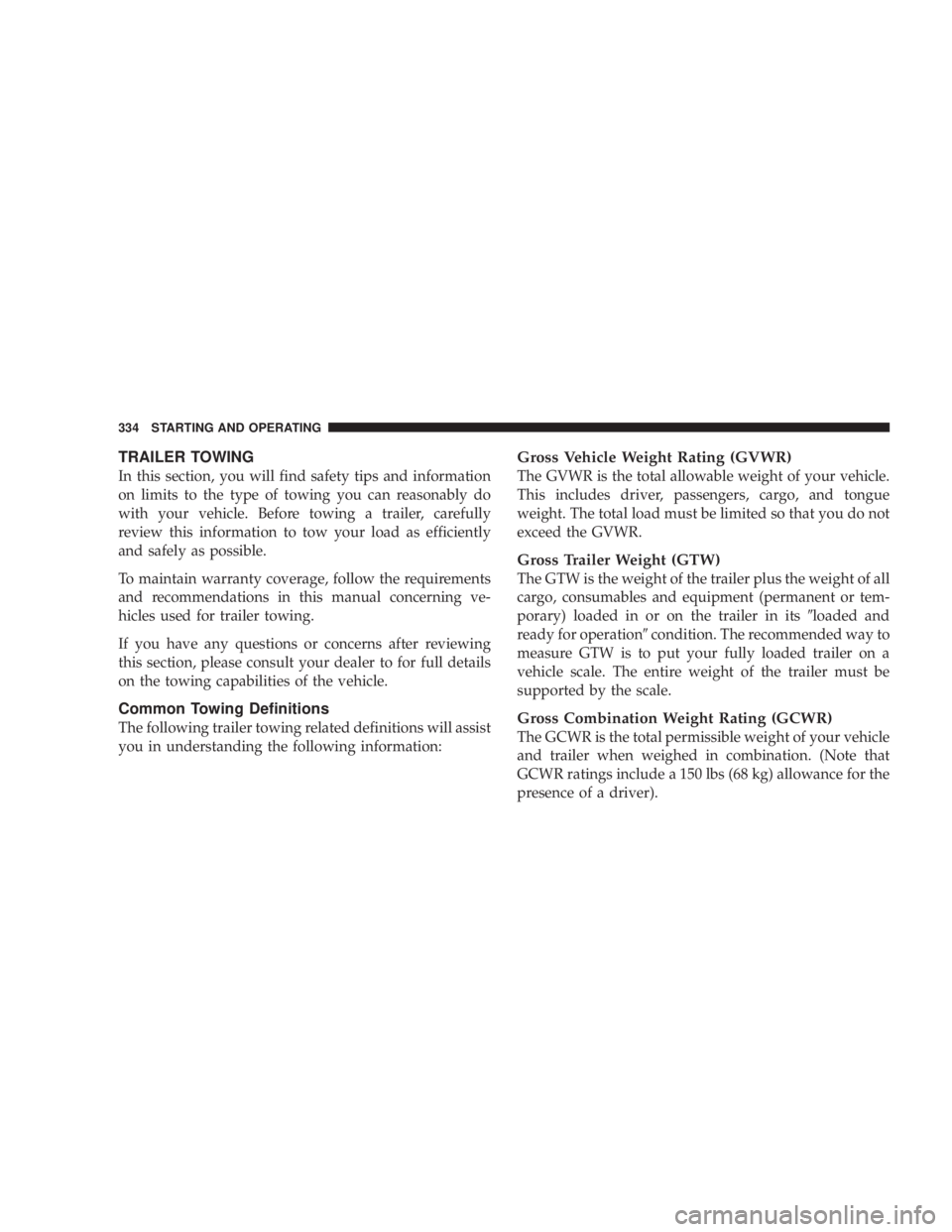
TRAILER TOWING
In this section, you will find safety tips and information
on limits to the type of towing you can reasonably do
with your vehicle. Before towing a trailer, carefully
review this information to tow your load as efficiently
and safely as possible.
To maintain warranty coverage, follow the requirements
and recommendations in this manual concerning ve-
hicles used for trailer towing.
If you have any questions or concerns after reviewing
this section, please consult your dealer to for full details
on the towing capabilities of the vehicle.
Common Towing Definitions
The following trailer towing related definitions will assist
you in understanding the following information: Gross Vehicle Weight Rating (GVWR)
The GVWR is the total allowable weight of your vehicle.
This includes driver, passengers, cargo, and tongue
weight. The total load must be limited so that you do not
exceed the GVWR.
Gross Trailer Weight (GTW)
The GTW is the weight of the trailer plus the weight of all
cargo, consumables and equipment (permanent or tem-
porary) loaded in or on the trailer in its 9 loaded and
ready for operation 9 condition. The recommended way to
measure GTW is to put your fully loaded trailer on a
vehicle scale. The entire weight of the trailer must be
supported by the scale.
Gross Combination Weight Rating (GCWR)
The GCWR is the total permissible weight of your vehicle
and trailer when weighed in combination. (Note that
GCWR ratings include a 150 lbs (68 kg) allowance for the
presence of a driver).334 STARTING AND OPERATING
Page 337 of 467
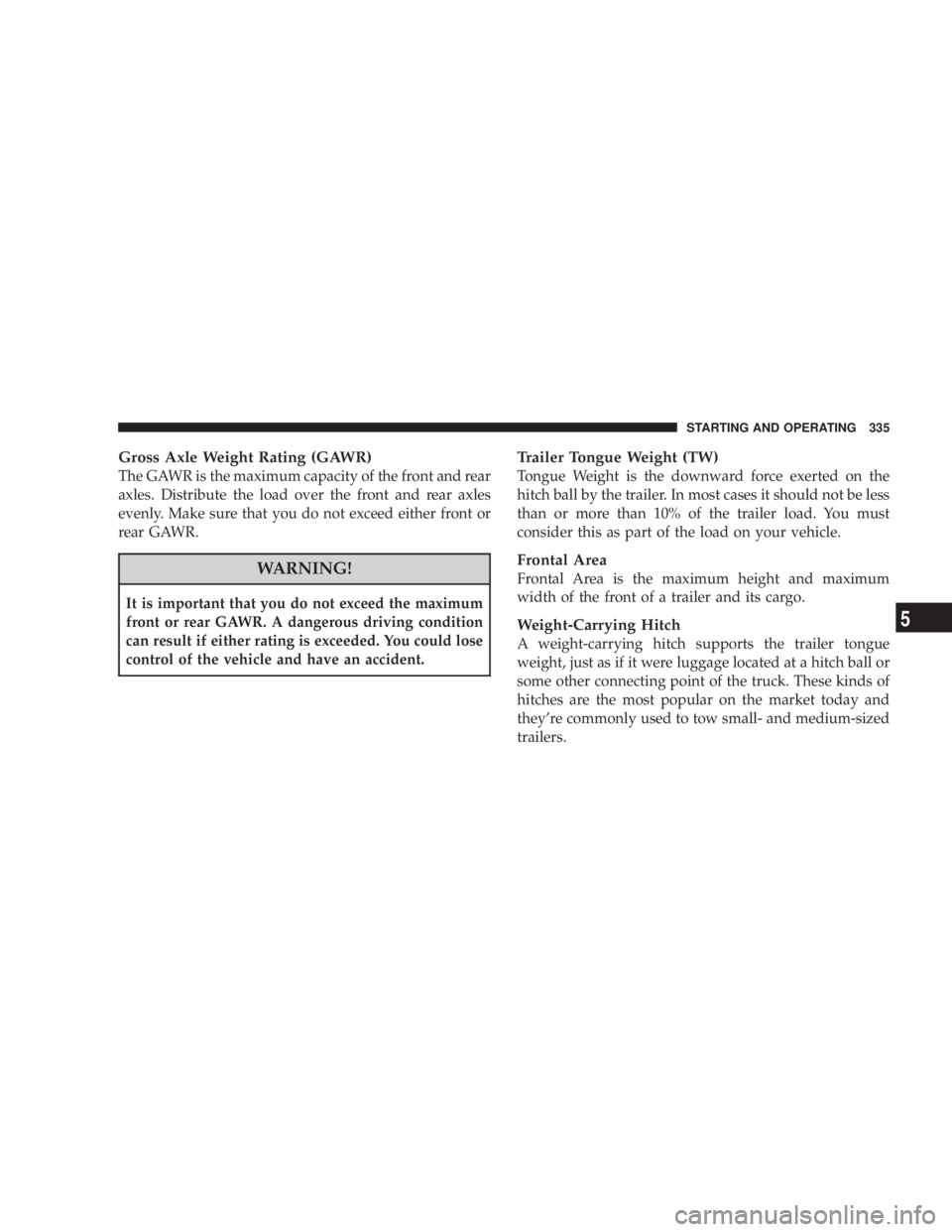
Gross Axle Weight Rating (GAWR)
The GAWR is the maximum capacity of the front and rear
axles. Distribute the load over the front and rear axles
evenly. Make sure that you do not exceed either front or
rear GAWR.
WARNING!It is important that you do not exceed the maximum
front or rear GAWR. A dangerous driving condition
can result if either rating is exceeded. You could lose
control of the vehicle and have an accident. Trailer Tongue Weight (TW)
Tongue Weight is the downward force exerted on the
hitch ball by the trailer. In most cases it should not be less
than or more than 10% of the trailer load. You must
consider this as part of the load on your vehicle.
Frontal Area
Frontal Area is the maximum height and maximum
width of the front of a trailer and its cargo.
Weight-Carrying Hitch
A weight-carrying hitch supports the trailer tongue
weight, just as if it were luggage located at a hitch ball or
some other connecting point of the truck. These kinds of
hitches are the most popular on the market today and
they're commonly used to tow small- and medium-sized
trailers. STARTING AND OPERATING 335
5
Page 338 of 467
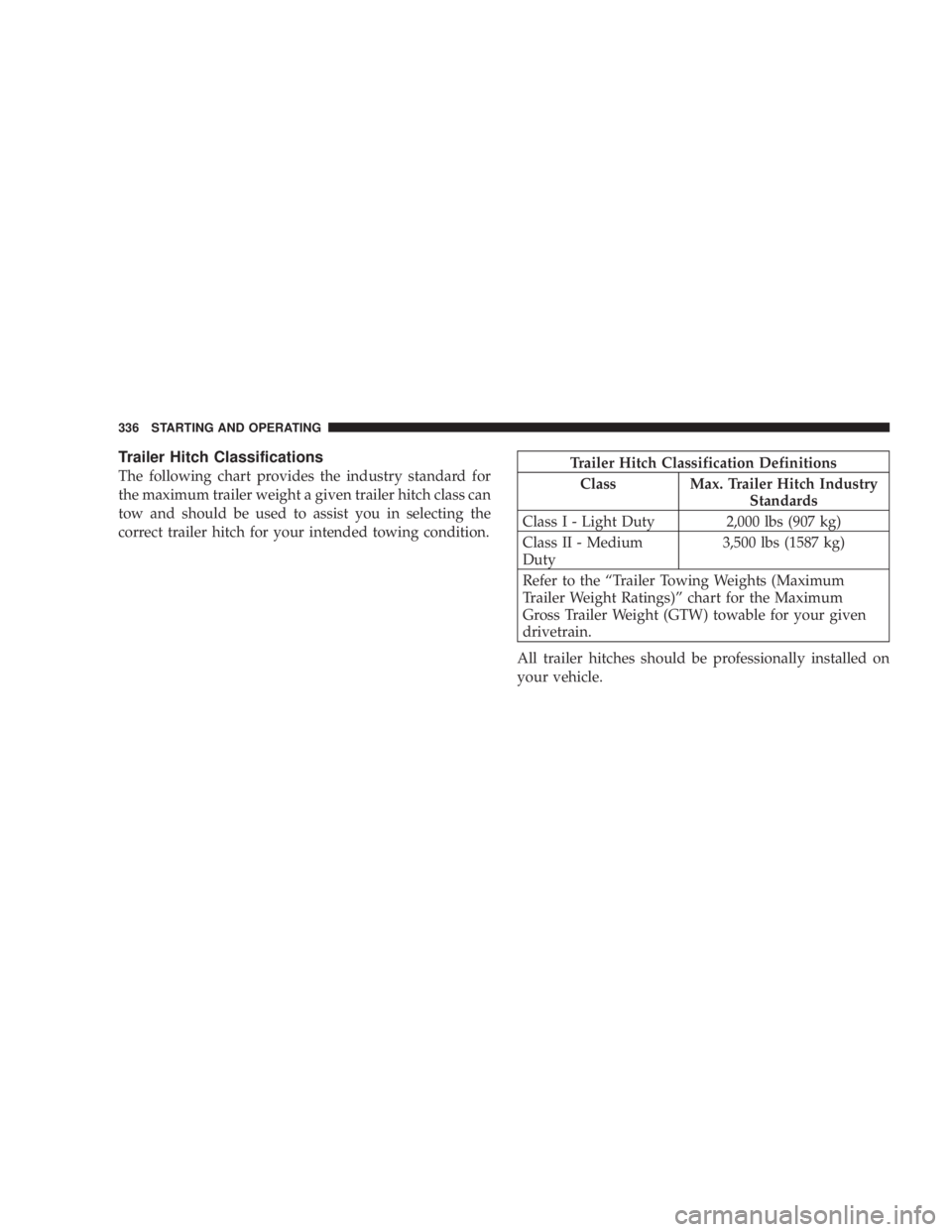
Trailer Hitch Classifications
The following chart provides the industry standard for
the maximum trailer weight a given trailer hitch class can
tow and should be used to assist you in selecting the
correct trailer hitch for your intended towing condition. Trailer Hitch Classification Definitions
Class Max. Trailer Hitch Industry
Standards
Class I - Light Duty 2,000 lbs (907 kg)
Class II - Medium
Duty 3,500 lbs (1587 kg)
Refer to the ªTrailer Towing Weights (Maximum
Trailer Weight Ratings)º chart for the Maximum
Gross Trailer Weight (GTW) towable for your given
drivetrain.
All trailer hitches should be professionally installed on
your vehicle.336 STARTING AND OPERATING
Page 339 of 467
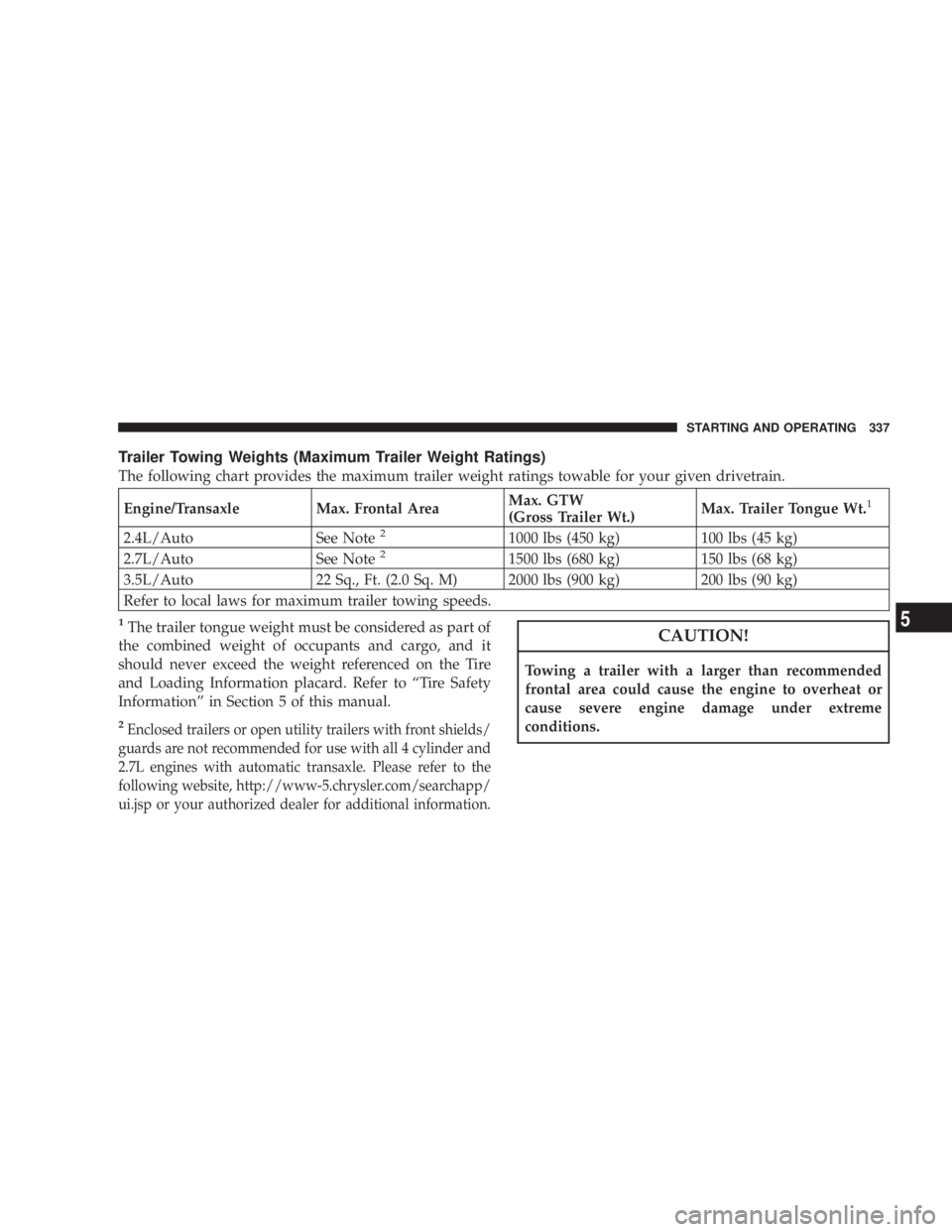
Trailer Towing Weights (Maximum Trailer Weight Ratings)
The following chart provides the maximum trailer weight ratings towable for your given drivetrain.
Engine/Transaxle Max. Frontal Area Max. GTW
(Gross Trailer Wt.) Max. Trailer Tongue Wt. 1
2.4L/Auto See Note 2
1000 lbs (450 kg) 100 lbs (45 kg)
2.7L/Auto See Note 2
1500 lbs (680 kg) 150 lbs (68 kg)
3.5L/Auto 22 Sq., Ft. (2.0 Sq. M) 2000 lbs (900 kg) 200 lbs (90 kg)
Refer to local laws for maximum trailer towing speeds. 1
The trailer tongue weight must be considered as part of
the combined weight of occupants and cargo, and it
should never exceed the weight referenced on the Tire
and Loading Information placard. Refer to ªTire Safety
Informationº in Section 5 of this manual. 2
Enclosed trailers or open utility trailers with front shields/
guards are not recommended for use with all 4 cylinder and
2.7L engines with automatic transaxle. Please refer to the
following website, http://www-5.chrysler.com/searchapp/
ui.jsp or your authorized dealer for additional information. CAUTION!Towing a trailer with a larger than recommended
frontal area could cause the engine to overheat or
cause severe engine damage under extreme
conditions. STARTING AND OPERATING 337
5
Page 340 of 467
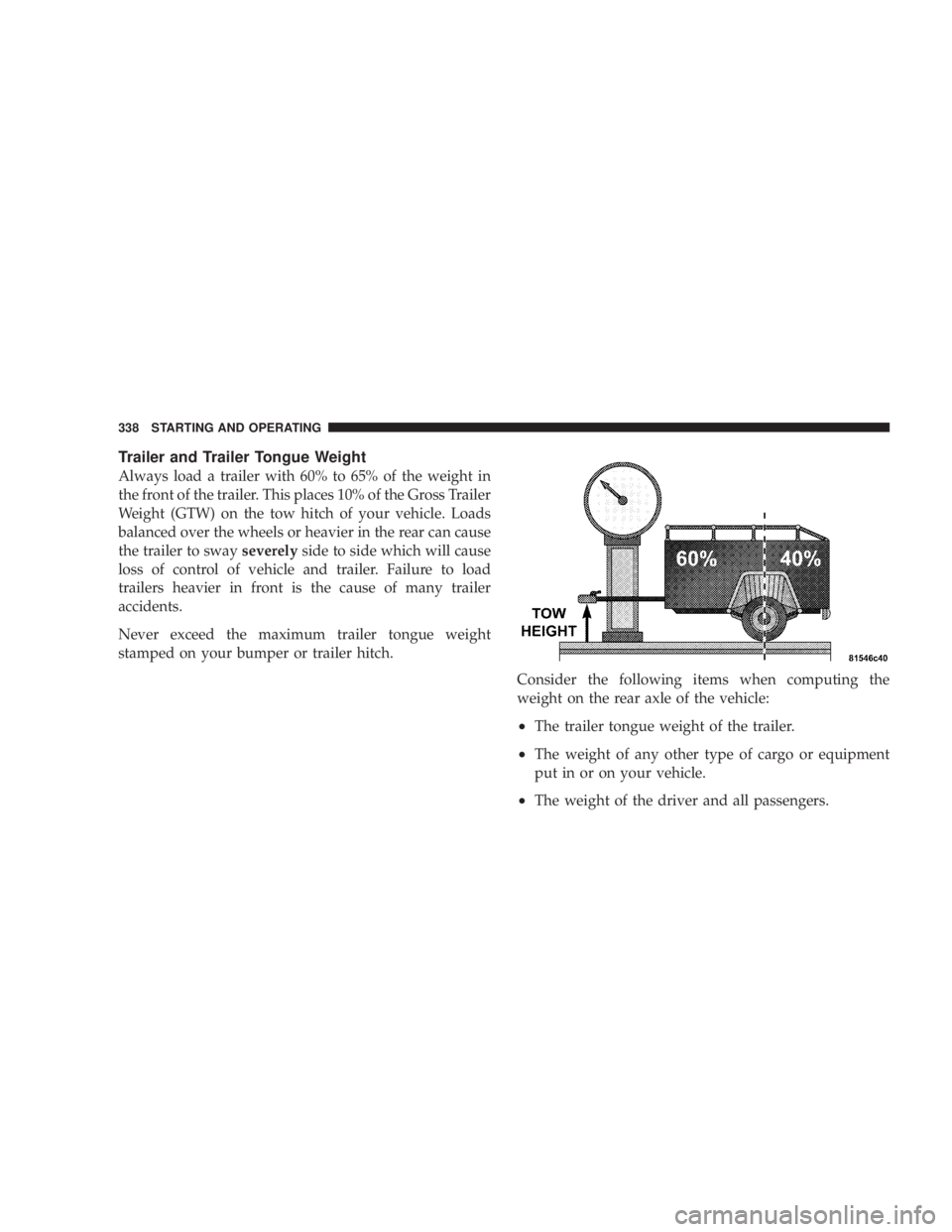
Trailer and Trailer Tongue Weight
Always load a trailer with 60% to 65% of the weight in
the front of the trailer. This places 10% of the Gross Trailer
Weight (GTW) on the tow hitch of your vehicle. Loads
balanced over the wheels or heavier in the rear can cause
the trailer to sway severely side to side which will cause
loss of control of vehicle and trailer. Failure to load
trailers heavier in front is the cause of many trailer
accidents.
Never exceed the maximum trailer tongue weight
stamped on your bumper or trailer hitch.
Consider the following items when computing the
weight on the rear axle of the vehicle:
² The trailer tongue weight of the trailer.
² The weight of any other type of cargo or equipment
put in or on your vehicle.
² The weight of the driver and all passengers.338 STARTING AND OPERATING